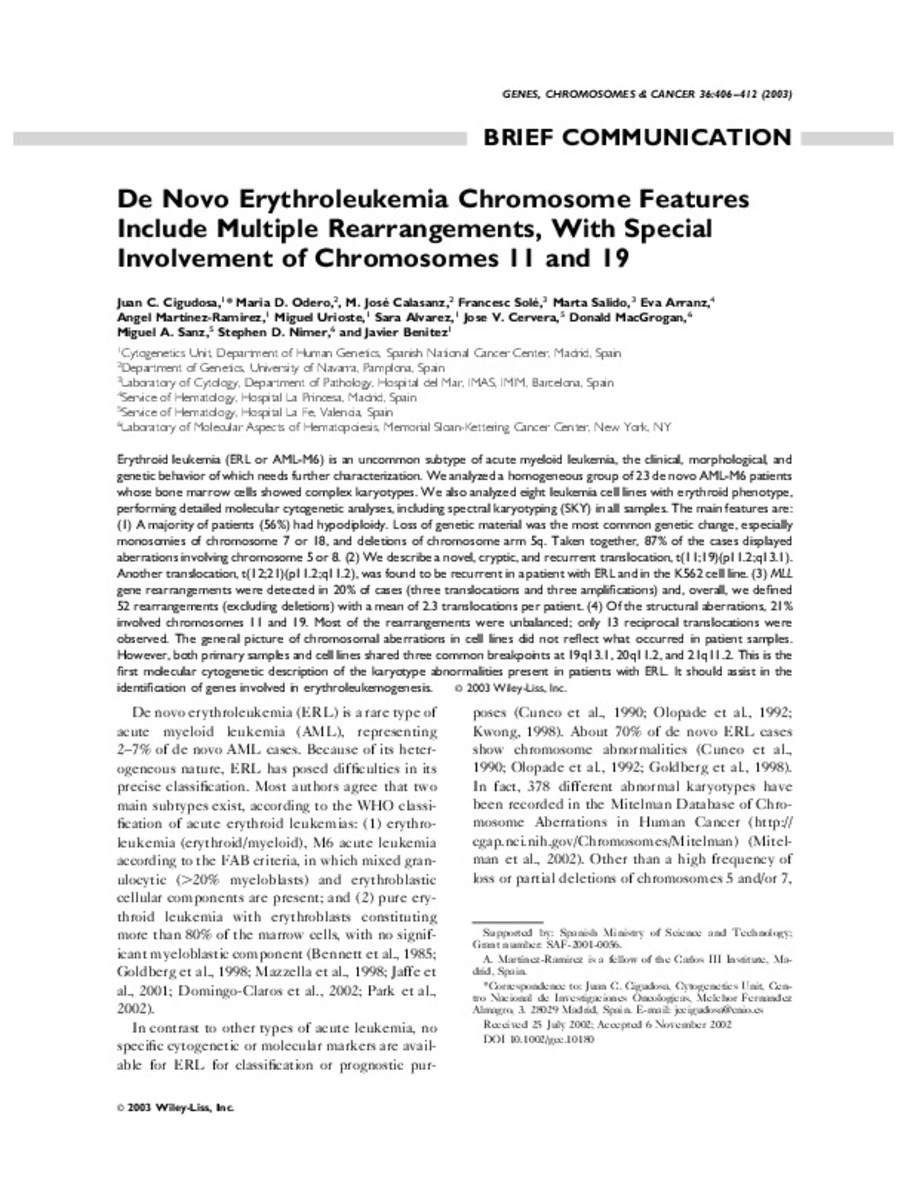Full metadata record
| DC Field | Value | Language |
|---|---|---|
| dc.creator | Cigudosa, J.C. (Juan Cruz) | - |
| dc.creator | Odero, M.D. (Maria Dolores) | - |
| dc.creator | Calasanz-Abinzano, M.J. (Maria Jose) | - |
| dc.creator | Sole, F. (Francesc) | - |
| dc.creator | Salido, M. (Marta) | - |
| dc.creator | Arranz, E. (Eva) | - |
| dc.creator | Martinez-Ramirez, A. (Angel) | - |
| dc.creator | Urioste, M. (Miguel) | - |
| dc.creator | Alvarez, S. (Sara) | - |
| dc.creator | Cervera, J.V. (Jose V.) | - |
| dc.creator | MacGrogan, D. (Donald) | - |
| dc.creator | Sanz, M.A. (Miguel A.) | - |
| dc.creator | Nimer, S.D. (Stephen D.) | - |
| dc.creator | Benitez, J. (Javier) | - |
| dc.date.accessioned | 2011-11-11T10:54:15Z | - |
| dc.date.available | 2011-11-11T10:54:15Z | - |
| dc.date.issued | 2003 | - |
| dc.identifier.citation | Cigudosa JC, Odero MD, Calasanz MJ, Sole F, Salido M, Arranz E, et al. De novo erythroleukemia chromosome features include multiple rearrangements, with special involvement of chromosomes 11 and 19. Genes Chromosomes Cancer 2003 Apr;36(4):406-412. | es_ES |
| dc.identifier.issn | 1098-2264 | - |
| dc.identifier.uri | https://hdl.handle.net/10171/19598 | - |
| dc.description.abstract | Erythroid leukemia (ERL or AML-M6) is an uncommon subtype of acute myeloid leukemia, the clinical, morphological, and genetic behavior of which needs further characterization. We analyzed a homogeneous group of 23 de novo AML-M6 patients whose bone marrow cells showed complex karyotypes. We also analyzed eight leukemia cell lines with erythroid phenotype, performing detailed molecular cytogenetic analyses, including spectral karyotyping (SKY) in all samples. The main features are: (1) A majority of patients (56%) had hypodiploidy. Loss of genetic material was the most common genetic change, especially monosomies of chromosome 7 or 18, and deletions of chromosome arm 5q. Taken together, 87% of the cases displayed aberrations involving chromosome 5 or 8. (2) We describe a novel, cryptic, and recurrent translocation, t(11;19)(p11.2;q13.1). Another translocation, t(12;21)(p11.2;q11.2), was found to be recurrent in a patient with ERL and in the K562 cell line. (3) MLL gene rearrangements were detected in 20% of cases (three translocations and three amplifications) and, overall, we defined 52 rearrangements (excluding deletions) with a mean of 2.3 translocations per patient. (4) Of the structural aberrations, 21% involved chromosomes 11 and 19. Most of the rearrangements were unbalanced; only 13 reciprocal translocations were observed. The general picture of chromosomal aberrations in cell lines did not reflect what occurred in patient samples. However, both primary samples and cell lines shared three common breakpoints at 19q13.1, 20q11.2, and 21q11.2. This is the first molecular cytogenetic description of the karyotype abnormalities present in patients with ERL. It should assist in the identification of genes involved in erythroleukemogenesis. | es_ES |
| dc.language.iso | eng | es_ES |
| dc.publisher | Wiley-Blackwell | es_ES |
| dc.rights | info:eu-repo/semantics/openAccess | es_ES |
| dc.subject | Chromosome Aberrations | es_ES |
| dc.subject | Chromosomes, Human, Pair 11/genetics | es_ES |
| dc.subject | Chromosomes, Human, Pair 19/genetics | es_ES |
| dc.subject | Gene Rearrangement/genetics | es_ES |
| dc.subject | Leukemia, Erythroblastic, Acute/genetic | es_ES |
| dc.title | De novo erythroleukemia chromosome features include multiple rearrangements, with special involvement of chromosomes 11 and 19 | es_ES |
| dc.type | info:eu-repo/semantics/article | es_ES |
| dc.identifier.doi | http://dx.doi.org/10.1002/gcc.10180 | es_ES |
Files in This Item:
Statistics and impact
Items in Dadun are protected by copyright, with all rights reserved, unless otherwise indicated.






